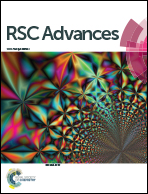Facile preparation of novel quaternary g-C3N4/Fe3O4/AgI/Bi2S3 nanocomposites: magnetically separable visible-light-driven photocatalysts with significantly enhanced activity†
Abstract
In this paper, we successfully fabricated quaternary g-C3N4/Fe3O4/AgI/Bi2S3 nanocomposites with various weight percents of Bi2S3, as novel magnetically separable visible-light-driven photocatalysts, using a facile refluxing method at 96 °C. The prepared samples were characterized by XRD, EDX, SEM, TEM, UV-vis DRS, FT-IR, TGA, BET, PL, and VSM techniques. Photocatalytic activity of the samples was investigated by degradation of rhodamine B, methylene blue, and fuchsine under visible-light illumination. It was found that photocatalytic activity of the g-C3N4/Fe3O4/AgI/Bi2S3 (30%) nanocomposite, as the optimal photocatalyst, in the degradation of RhB is nearly 56, 44, 6.5, and 16-folds higher than those of the g-C3N4, g-C3N4/Fe3O4, g-C3N4/Fe3O4/AgI (20%), and g-C3N4/Fe3O4/Bi2S3 (30%) samples, respectively. Furthermore, the effects of refluxing time, calcination temperature, scavengers of the reactive species, and number of recycling runs on the photocatalytic activity were investigated. Based on the results, the improved photocatalytic activity was attributed to the enhanced visible-light absorption ability and matching energy levels of the counterparts that facilitate generation and separation of electron–hole pairs, respectively.


 Please wait while we load your content...
Please wait while we load your content...